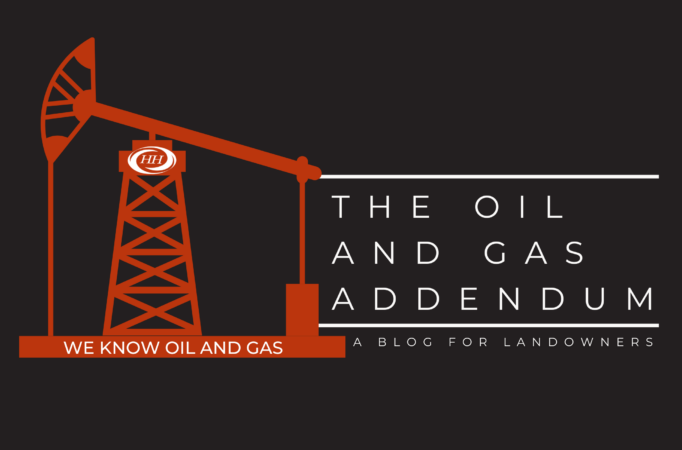The Oil and Gas Addendum
Pore Space: The Next Leasing Frontier for Pennsylvania Landowners?
Let’s assume you own a 135 acre farm in Washington County. In 1976, your grandfather signed an oil and gas lease with ABC Oil. Several years later, ABC Oil drilled three shallow vertical gas wells on the farm. They are still producing and you receive a modest royalty every quarter. In April 2022, you are approached by a landman for a company called Hydrogen Drilling. The landman asks if you are interested in leasing the “pore space” beneath the farm. You have never heard of such a thing. The landman says Hydrogen Drilling wants to inject and store captured carbon emissions in the “pore space”. A few days later, a landman from ABC Oil approaches you and says that ABC Oil has the exclusive right to inject and store carbon emissions pursuant to the 1976 Lease. He claims that the pore space has already been leased as part of the 1976 Lease. You are puzzled and confused. Do you actually own the empty space between the layers of rock beneath the farm? Can you lease these subsurface spaces to Hydrogen Drilling without breaching the 1976 Lease? Or does ABC Oil already have these rights? The question of who owns the subsurface “pore space” and who has the right to use those voids is fast becoming one of the hot topics in Harrisburg and beyond as the concept of carbon sequestration gains national traction. Landowners across Pennsylvania need to closely monitor this evolving issue as it could impact existing oil and gas leases.
To appreciate the significance of this issue, we first have to understand the interplay between carbon sequestration and underground storage. Carbon sequestration refers to the process by which carbon emissions are captured prior to discharge into the atmosphere. The captured carbon, however, must be stored somewhere safe and for a very long time. That is where underground storage comes into play- the captured carbon must be injected into the rock formations thousands of feet below the surface. Where does the injected carbon actually go? Into the proverbial “pore space”.
Pore space is generally described as the empty space or cavity between layers or grains of rock. It is most often associated with depleted oil and gas reservoirs. In other words, once the oil or gas is drained and extracted from a reservoir, what remains is a geologic void (i.e. the space formerly filled by the hydrocarbons). This void is known as the pore space.
Who owns the pore space? More importantly, who controls the use of the pore space after an oil and gas lease has been signed? There are two schools of thought on this issue. Under the so-called “American Rule”, the owner of the surface estate generally owns and controls the pore space. This is the majority position in the United States. See, Burlington Resources Oil & Gas Company, LP v. Lang and Sons Incorporated, 259 P.3d 766 (Mont. 2021) (“…pore space beneath the property belongs to the surface estate…”); Southern Natural Gas Company v. Sutton, 406 So. 2d 669 (La. Ct. App. 1981) (“…surface ownership, however, includes the right to use the reservoir underlying the land for storage purposes”); Department of Transportation v. Goike, 560 N.W. 2d 365 (Mich. Ct. App. 1996) (“the storage space, once it has been evacuated of minerals and gas, belongs to the surface owner”); Mosser v. Denbury Resources, Inc.,898 N.W.2d 406 (N.D. 2017) (“…we agree with the interpretations by the federal magistrate judge and the federal district court judge that pore space is part of the surface owner’s interest…”); Emeny v. United States, 412 F.2d 1319 (Ct. Cl. 1969) (owner of the surface owns the “geological structures beneath the surface, including any such structures that might be suitable for the underground storage of foreign or extraneous gas”); See also, WYOMING STAT § 34-1-152(A) (“[T]he ownership of all pore space in all strata below the surface lands and water of this state is declared to be vested in the several owners of the surface above the strata”). The minority view is known as the “English Rule.” Under this approach, the owner of the mineral estate and/or the lessee controls the pore space. See, Hammonds v. Central Kentucky Natural Gas Co., 75 SW 2d 204 (Ky. Ct. App. 1934) (overruled Texas American Energy Corp. v. Citizens Fidelity Bank & Trust Co., 736 SW 2d 25 (Ky. 1987)). No Pennsylvania court has directly addressed this particular question. Nonetheless, the author submits that Pennsylvania should and will follow the “American Rule”.
Although the precise issue of pore space ownership was not before the court in Pomposini v. T.W. Phillips Gas and Oil Company, 580 A.2d 776 (Pa. Super. Ct. 1990), the opinion itself strongly suggests that Pennsylvania falls within the “American Rule”. At issue in Pomposini was a 1946 oil and gas lease encumbering 175 acres in Indiana County, Pennsylvania (the “1946 Lease”). The 1946 Lease required the lessee to pay a quarterly rental of $43.75 per acre until it commenced operations, and thereafter the rental was to be determined according to a sliding scale based on well pressure. In 1953, the lessee drilled a shallow well and produced gas from that well until 1954 when it was converted into an injection well. Thereafter, the well was only used to inject and store gas into the depleted subsurface reservoir. The landowner continued to receive rentals but was unaware that the well was no longer producing gas. He brought suit in 1981 after he learned that the leasehold was only being used for gas storage. His complaint alleged that the 1946 Lease did not grant storage rights and that the injection and storage of foreign gas was therefore unauthorized. The Superior Court agreed and opined:
“[B]ecause the lessee did not acquire an estate in the caverns and was not authorized to store gas on plaintiff’s land, the trial court correctly held that the lessee was liable for unauthorized storage of gas…”
The take away from Pomposini is that unless an oil and gas lease specifically grants the right to inject and store gas, no gas storage rights can be implied in the lease itself. In other words, the right to use and control the subsurface caverns and voids (i.e. pore space) must be expressly set forth in the underlying lease. Otherwise, under Pomposini, they are exclusively retained and reserved by the landowner. Although Pomposini was a gas storage case, the logic and rationale espoused by the Superior Court should equally apply to carbon sequestration. Returning to our example, unless the 1976 Lease expressly granted specific storage rights, ABC Oil does not have the right to use or control the pore space. If ABC Oil or Hydrogen Drilling want to inject and store captured carbon emissions, a new pore space lease will need to be negotiated.
The concept of carbon capture and sequestration is quickly gaining steam in Harrisburg. Earlier this spring, Senator Gene Yaw (R-23) released a Co-Sponsorship Memorandum entitled “Pennsylvania Geologic Storage of Carbon Dioxide Act”. The proposed legislation “…will help [Pennsylvania] fight climate change by becoming a leader in the effort to capture and store emissions of carbon dioxide…” According to Senator Yaw’s memorandum, part of the new legislation will “[D]esignate property rights around storage sites in deep geologic formations”. It is unclear exactly what this means or how the new legislation will impact, or perhaps impair, the landowner’s right to control the pore space. As noted, a strong argument can be made that the surface owner and/or lessor controls the pore space. This means that if someone wants to use the pore space to store captured carbon emissions, they need your approval and consent in the form of a new pore space lease. Landowners across Pennsylvania should closely monitor this proposed legislation as it may alter or change the rules concerning access to the pore space.
About Us
Oil and gas development can present unique and complex issues that can be intimidating and challenging. At Houston Harbaugh, P.C., our oil and gas practice is dedicated to protecting the interests of landowners and royalty owners. From new lease negotiations to title disputes to royalty litigation, we can help. Whether you have two acres in Washington County or 5,000 acres in Lycoming County, our dedication and commitment remains the same.
We Represent Landowners in All Aspects of Oil and Gas Law
The oil and gas attorneys at Houston Harbaugh have broad experience in a wide array of oil and gas matters, and they have made it their mission to protect and preserve the landowner’s interests in matters that include:
- New lease negotiations
- Pipeline right-of-way negotiations
- Surface access agreements
- Royalty audits
- Tax and estate planning
- Lease expiration claims
- Curative title litigation
- Water contamination claims

Robert Burnett - Practice Chair
Robert’s practice is exclusively devoted to the representation of landowners and royalty owners in oil and gas matters. Robert is the Chair of the Houston Harbaugh’s Oil & Gas Practice Group and represents landowners and royalty owners in a wide array of oil and gas matters throughout the Commonwealth of Pennsylvania. Robert assists landowners and royalty owners in the negotiation of new oil and gas leases as well as modifications to existing leases. Robert also negotiates surface use agreements and pipeline right-of-way agreements on behalf of landowners. Robert also advises and counsels clients on complex lease development and expiration issues, including the impact and effect of delay rental and shut-in clauses, as well as the implied covenants to develop and market oil and gas. Robert also represents landowners and royalty owners in disputes arising out of the calculation of production royalties and the deduction of post-production costs. Robert also assists landowners with oil and gas title issues and develops strategies to resolve and cure such title deficiencies. Robert also advises clients on the interplay between oil and gas leases and solar leases and assists clients throughout Pennsylvania in negotiating solar leases.

Brendan A. O'Donnell
Brendan O’Donnell is a highly qualified and experienced attorney in the Oil and Gas Law practice. He also practices in our Environmental and Energy Practice. Brendan represents landowners and royalty owners in a wide variety of matters, including litigation and trial work, and in the preparation and negotiation of:
- Leases
- Pipeline right of way agreements
- Surface use agreements
- Oil, gas and mineral conveyances

